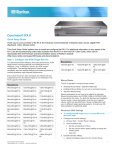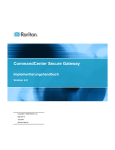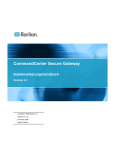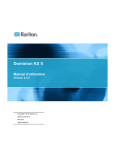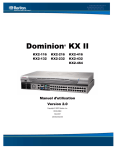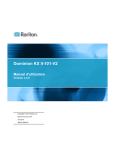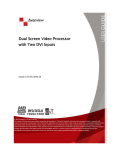Download Raritan Computer II-101 User's Manual
Transcript
Dominion® KX II-101 Quick Setup Guide Thank you for your purchase of the KX II-101, the industry's most full-featured, enterprise-class, secure, digital KVM (Keyboard, Video, Mouse) switch. This Quick Setup Guide explains how to install and configure the KX II-101. For additional information on any aspect of the KX II-101, see the accompanying KX II-101 User Guide, which can be downloaded from the Firmware and Documentation section (http://www.raritan.com/support/firmware-and-documentation/) of Raritan's website. Step 1: Configure the Target Server For optimal bandwidth efficiency and video performance, a target server running a graphical user interface such as Windows, X-Windows, Solaris, and KDE should be configured with desktop backgrounds set to a predominantly solid, light-colored graphic. Backgrounds featuring photos or complex gradients should be avoided. Ensure that the server's video resolution and refresh rate are supported by the KX II-101, and that the signal is non-interlaced. The KX II-101 supports the following video resolutions: Resolutions 720x400 @70 Hz 1024x768 @75 Hz 1280x1024 @85 Hz 720x400 @84 Hz 1024x768 @85 Hz 1600x1200 @60 Hz Mouse Modes The KX II-101 operates in several mouse modes: Absolute Mouse Synchronization™, Intelligent Mouse mode (do not use an animated mouse), and Standard Mouse mode. Resolutions 640x350 @70 Hz 720x400 @85 Hz 1024x768 @90 Hz 640x350 @85 Hz 800x600 @56 Hz 1024x768 @100 Hz 640x400 @56 Hz 800x600 @60 Hz 1152x864 @60 Hz 640x400 @84 Hz 800x600 @70 Hz 1152x864 @70 Hz 640x400 @85 Hz 800x600 @72 Hz 1152x864 @75 Hz 640x480 @60 Hz 800x600 @75 Hz 1152x864 @85 Hz 640x480 @66.6 Hz 800x600 @85 Hz 1152x870 @75.1 Hz 640x480 @72 Hz 800x600 @90 Hz 1152x900 @66 Hz 640x480 @75 Hz 800x600 @100 Hz 1152x900 @76 Hz 640x480 @85 Hz 832x624 @75.1 Hz 1280x960 @60 Hz 640x480 @90 Hz 1024x768 @60 Hz 1280x960 @85 Hz 640x480 @100 Hz 1024x768 @70 Hz 1280x1024 @60 Hz 640x480 @120 Hz 1024x768 @72 Hz 1280x1024 @75 Hz Mouse parameters do not have to be altered for Absolute Mouse Synchronization. For both the Standard and Intelligent Mouse modes, mouse parameters must be set to specific values, which are described in this section. Mouse configurations will vary on different target operating systems. Consult your OS documentation for additional details. Windows 2000® Settings To configure the mouse: KX II-101 Quick Setup Guide QSG-DKX2-101-v2.40-0C-E y 255-62-3061-00 1. Choose Start > Control Panel > Mouse. 2. On the Motion tab, set the acceleration to None and set the mouse motion speed setting to exactly the middle speed. Click OK. To disable transition effects: 1. Select the Display option from Control Panel. 2. On the Effects tab, deselect the Use the following transition effect for menus and tooltips checkbox. Click OK. 1 Windows XP®/Windows 2003® Settings To configure the mouse: 1. Select Start > Control Panel > Mouse. 2. On the Pointer Options tab in the Motion group, set the mouse motion speed setting to exactly the middle speed and deselect the Enhanced pointer precision checkbox. Click OK. To disable transition effects: 1. Select Start > Control Panel > Display. 2. On the Appearance tab, click the Effects button. 3. Deselect the Use the following transition effect for menus and tooltips checkbox. Click OK. Windows Vista® Settings To configure the mouse: 1. Select Start > Settings > Control Panel > Mouse. 2. On the Pointer Options tab in the Motion group, set the mouse motion speed setting to exactly the middle speed and deselect the Enhanced pointer precision option. Click OK. To disable animation and fade effects: 1. Select Start > Settings >Control Panel > System > Advanced system settings. The System Properties dialog appears. 2. Click the Advanced tab and click the Settings button in the Performance group. The Performance Options dialog appears. 3. Under Custom options, deselect the following checkboxes: Animate controls and elements inside windows Animate windows when minimizing and maximizing Fade or slide menus into view Fade or slide ToolTips into view Fade out menu items after clicking 4. Click OK. Linux® Settings On a target server running Linux graphical interfaces, set the mouse acceleration to exactly 1 and set threshold to exactly 1. Enter the command xset mouse 1 1. Ensure that a target server running Linux is using a resolution supported by the KX II-101 at a standard VESA resolution and refresh rate. A Linux target server should also be set so the blanking times are within +/- 40% of VESA standard values. To check for these parameters: 1. Go to the Xfree86 Configuration file XF86Config. 2. Using a text editor, disable all non-KX II-101 supported resolutions. 3. Disable the virtual desktop feature, which is not supported by the KX II-101. 4. Check blanking times (+/- 40% of VESA standard). KX II-101 Quick Setup Guide QSG-DKX2-101-v2.40-0C-E y 255-62-3061-00 5. Restart the computer. Note: In many Linux graphical environments, the command Ctrl+Alt+ + (plus sign) changes the video resolution, scrolling through all available resolutions that remain enabled in the XF86Config file. Sun™ Solaris™ Settings Set the mouse acceleration value to exactly 1 and the threshold to exactly 1. A target server running the Solaris operating system must output VGA video (H-and-V sync, not composite sync). Set this at the graphical user interface or with the command line xset mouse a t where a is the acceleration and t is the threshold. Apple Macintosh® Settings Mac works with the KX II-101 'out of the box.' However, you must use Absolute Mouse Synchronization and enable Absolute Mouse mode and mouse scaling for Mac servers on the KX II-101 Port page. To enable this setting: 1. Choose Device Settings > Port Configuration. The Port Configuration Page opens. 2. Click the Port Name for the port you want to edit. 3. In the USB Connection Settings section, select the Enable Absolute Mouse checkbox and the "Enable Absolute mouse scaling for MAC server" checkbox. Click OK. IBM AIX® Settings 1. Go to the Style Manager. 2. Click on Mouse Settings and set the Mouse Acceleration to 1.0 and Threshold to 3.0. QS Rule Step 2: Configure Network Firewall Settings To access the KX II-101 through a network firewall, your firewall must allow communication on TCP Port 5000. Alternatively, the KX II-101 can be configured to use a different TCP port of your own designation. To take advantage of the KX II-101's web-access capabilities, the firewall must allow inbound communication on TCP Port 443 - the standard TCP port for HTTPS communication. To take advantage of the KX II-101's redirection of HTTP requests to HTTPS (so that users may type the more common, http://xxx.xxx.xxx.xxx, instead of https://xxx.xxx.xxx.xxx), the firewall must also allow inbound communication on TCP Port 80 - the standard TCP port for HTTP communication. QS Rule Step 3: Connect the KX II-101 Power The KX II-101 can be powered with either the included standard AC power pack or by PoE (Power over Ethernet). 2 • • For standard AC power, plug the included AC power adaptor kit into the Power port and plug the other end into a nearby AC power outlet. For PoE, attach a 10/100Mbps cable to the LAN port and plug the other end into a PoE-provisioned LAN. After the KX II-101 is powered ON, it goes through a boot-up sequence, during which the blue Raritan-logo LED will blink for about 45 seconds. Upon successful boot-up, the back-lit LED remains lit. Diagram key Local monitor, keyboard, and mouse. Note: 1, 2 and 3 are required if local access to the target is required. Note: B also requires an integrated PS2 keyboard, video and mouse cable, with only the video connected. Target Server The KX II-101 can use either the included USB cable or integrated PS/2 cables to connect to the target server. Before connecting, configure your target server's video to a supported resolution. Note: For PS/2 configurations that require virtual media connectivity, the USB connector is also necessary. Note: To ensure the best connectivity using a USB cable, only use the USB cable provided with the KX II-101. To configure the KX II-101 for use with a USB target server: 1. Connect the mini-USB connector to the KX II-101 and the USB connector to a USB port on the target server. 2. Use the attached video cable to connect the KX II-101 to the target video port. 3. Use the optional PS/2 DKX2-101-LPKVMC cabling to attach only the local video to the Local User port of the KX II-101. Sold Separately Note: The KX II-101 must be powered for the Local User port to function. USB Configuration 4. Use USB cables to connect the keyboard and mouse directly to the target server. To configure the KX II-101 for use with a USB target server: 1. Connect the mini-USB connector to the KX II-101 and the USB connector to a USB port on the target server. 2. Use the attached video cable to connect the KX II-101 to the target video port. 3. Use the optional PS/2 DKX2-101-LPKVMC cabling to attach only the local video to the Local User port of the KX II-101. Sold Separately Note: The KX II-101 must be powered for the Local User port to function. 4. Use USB cables to connect the keyboard and mouse directly to the target server. To configure the KX II-101 for use with a USB target server: Diagram key Target server USB connection from the target server to the mouse. Included mini-USB to USB cable from the KX II-101 to the target server. USB connection from the target server to the keyboard. KX II-101 Video connection to the local monitor. KX II-101 Quick Setup Guide QSG-DKX2-101-v2.40-0C-E y 255-62-3061-00 1. Connect the mini-USB connector to the KX II-101 and the USB connector to a USB port on the target server. 2. Use the attached video cable to connect the KX II-101 to the target video port. 3. Use the optional PS/2 DKX2-101-LPKVMC cabling to attach only the local video to the Local User port of the KX II-101. Sold Separately Note: The KX II-101 must be powered for the Local User port to function. 4. Use USB cables to connect the keyboard and mouse directly to the target server. 3 2. Use the PS/2 cabling to attach the local keyboard, video, and mouse to the Local User port of the KX II-101. PS/2 Configuration Note: The KX II-101 must be powered for the Local User port to function. 3. If you require Virtual Media (VM) connectivity, connect the mini-USB connector to the KX II-101 and the USB connector to any USB port on the target server. Network Connect a standard Ethernet cable from the network port labeled LAN to an Ethernet switch, hub, or router. The LAN LEDs that appear above the Ethernet connection indicate Ethernet activity. The yellow one blinks while the KX II-101 is in use, indicating IP traffic at 10 Mbps. The green light indicates a 100 Mbps connection speed. Admin Port The Admin port enables you to perform configuration and setup for the KX II-101 using a terminal emulation program like HyperTerminal. Plug the min-DIN end of the included serial cable into the Admin port of the KX II-101 and plug the DB9 end into a serial port on your PC or laptop. The serial port communication settings should be configured to the following: Diagram key Target server Integrated PS/2 keyboard, video, and mouse connections from the KX II-101 to the target server • • • • • 115,200 Baud 8 data bits 1 stop bit No parity No flow control See Configure the KX II-101 Using a Terminal Emulation Program the KX II-101 User Guide for more details. Included mini-USB to USB connector from the KX II-101 to the target server for Virtual Media connectivity PS/2 connection from the KX II-101 to the mouse (optional) KX II-101 PS/2 connection from the KX II-101 to the keyboard (sold separately) The KX II-101 is available with optional video and PS/2 cables (KX II-101-LPKVMC) that enable you to attach a keyboard and mouse to the target server through the Local User port. The Local User port serves as a pass-through to the target server to which the KX II-101 is attached and has no other purpose. The KX II-101 must be powered on to use the Local User port. Local monitor, keyboard, and mouse Video connection to the local monitor (optional) For USB configurations, only the local video connects to the target server at the Local User port. The keyboard and mouse connect directly to the target server using USB ports. Note: 1, 2 and 3 are required if local access to the target is required. Local User Port Note: Only PS/2 host interface connectivity is supported on the Local User port and you must restart the target server after connecting to the KX II-101 using PS/2 connectors. QS Rule To configure the KX II-101 for use with a PS/2 target server: 1. Use the attached PS/2 keyboard, video, and mouse cabling to connect the KX II-101 to the target server. KX II-101 Quick Setup Guide QSG-DKX2-101-v2.40-0C-E y 255-62-3061-00 4 Step 4: Configure the KX II-101 With this option, network parameters are assigned by the DHCP server. If DHCP is used, enter the Preferred host name (DHCP only). Up to 80 characters. Change the Default Password When you first log into the Remote Console, you are prompted to set a new password to replace the default. Then you can configure the KX II-101. 1. Log into a workstation with network connectivity to your KX II-101 device. 2. Launch a supported web browser such as Internet Explorer (IE) or Firefox. 3. In the address field of the browser, enter the default IP address of the device: 192.168.0.192. 4. Press Enter. The login page opens. 5. Enter the user name admin and the password raritan. 6. Click Login. The Change Password page is displayed. 7. Type raritan in the Old Password field. 8. Type a new password in the New Password field and the Confirm New Password field. Passwords can be up to 64 characters long and can consist of English alphanumeric and printable special characters. 9. Click Apply. You will receive confirmation that the password was successfully changed. 10. Click OK. The Port Access page opens. Assign an IP Address 1. Choose Device Settings > Network. The Network Settings page opens. 2. Specify a meaningful Device Name for your KX II-101 device using up to 32 alphanumeric characters, valid special characters, and no spaces. 3. In the IP Address section, enter or select the appropriate network settings: a. Enter the IP Address if needed. The default IP address is 192.168.0.192. b. Enter the Subnet Mask. The default subnet mask is 255.255.255.0. c. Enter the Default Gateway if None is selected from the IP Auto Configuration drop-down. d. Enter the Preferred DHCP Host Name if DHCP is selected from the IP Auto Configuration drop-down. Note: The recommended maximum host name length is 80 characters. e. Select the IP Auto Configuration. The following options are available: None (Static IP) - This option requires that you manually specify the network parameters. This is the recommended option because the KX II-101 is an infrastructure device and its IP address should not change. DHCP - Dynamic Host Configuration Protocol is used by networked computers (clients) to obtain unique IP addresses and other parameters from a DHCP server. KX II-101 Quick Setup Guide QSG-DKX2-101-v2.40-0C-E y 255-62-3061-00 4. Select Obtain DNS Server Address Automatically if DHCP is selected and Obtain DNS Server Address is enabled. When Obtain DNS Server Address Automatically, the DNS information provided by the DHCP server will be used. 5. If Use the Following DNS Server Addresses is selected, regardless of whether DHCP is selected, the addresses entered in this section will be used to connect to the DNS server. Enter the following information if the Following DNS Server Addresses option is selected. These addresses are the primary and secondary DNS addresses that will be used if the primary DNS server connection is lost due to an outage. a. Primary DNS Server IP Address b. Secondary DNS Server IP Address 6. When finished, click OK. Your KX II-101 is now network accessible. QS Rule Step 5: Create User Groups and Users To add a new user group: 1. Open the Group page by selecting User Management > Add New User Group or clicking the Add button from the User Group List page. The Group page is organized into the following categories: Group, Permissions, Port Permissions, and IP ACL. 2. Type a descriptive name for the new user group into the Group Name field. 3. Set the permissions for the group. Select the checkboxes before the permissions you want to assign to all of the users belonging to this group. 4. Set the port permissions. Specify the server ports that can be accessed by users belonging to this group (and the type of access). 5. Set the IP ACL. This feature limits access to the KX II-101 device by specifying IP addresses. It applies only to users belonging to a specific group, unlike the IP Access Control list feature that applies to all access attempts to the device (and takes priority). Optional 6. Click OK. To add a new user: 1. Open the User page by choosing User Management > Add New User or clicking the Add button on the User List page. 2. Type a unique name in the Username field (up to 16 characters). 3. Type the person's full name in the Full Name field (up to 64 characters). 4. Type a password in the Password field and retype the password in the Confirm Password field (up to 64 characters). 5 5. Choose the group from the User Group drop-down list. The list contains all groups you have created in addition to the system-supplied default groups. <Unknown>, which is the default setting, Admin, Individual Group. If you do not want to associate this user with an existing User Group, select Individual Group from the drop-down list. For more information about permissions for an Individual Group. 6. To activate the new user, select the Active checkbox. The default is activated (enabled). 7. Click OK. QS Rule Additional Information For more information about the KX II-101 and the entire Raritan product line, see Raritan's website (www.raritan.com). For technical issues, contact Raritan Technical Support. See the Contact Support page in the Support section on Raritan's website for technical support contact information worldwide. KX II-101 Quick Setup Guide QSG-DKX2-101-v2.40-0C-E y 255-62-3061-00 6






